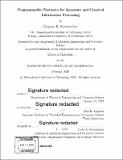Programmable photonics for quantum and classical information processing
Author(s)
Steinbrecher, Gregory R.
Download1122779802-MIT.pdf (22.31Mb)
Other Contributors
Massachusetts Institute of Technology. Department of Electrical Engineering and Computer Science.
Advisor
Dirk R. Englund.
Terms of use
Metadata
Show full item recordAbstract
In this thesis, I explore the application of integrated photonic systems to quantum information processing as well as quantum and classical communications. The common thread throughout this work is the efficacy of variational numerical optimization in the design and optimization of photonic/bosonic systems. I present the programmable nanophotonic processor (PNP) platform that we developed, which is one way to realize an arbitrarily reconfigurable linear optics platform. I explore the prospects of realizing high fidelity quantum gates in this system, demonstrating through black box numerical optimization that we can compensate for a realistic model of fabrication error in the silicon photonics platform. Next, I discuss the design and construction of a next-generation PNP laboratory testbed, from the silicon photonics design up through the thermal and mechanical packaging, and the custom control and monitoring electronics. I discuss experiments using PNPs as a novel type of optical network switch, capable of both unicast and multicast operation, demonstrating its benefits in a small network testbed. Looking towards the future, I show that the integration of optical nonlinearities with PNPs would enable a quantum optical neural network (QONN) platform, demonstrating through simulation that these QONNs can be optimized to perform a variety of quantum and classical information processing tasks. I then expand the application of these systems from information processing to communications, showing that QONNs provide a natural platform to realize one-way quantum repeaters. Finally, I demonstrate the efficacy of the numerical techniques used in this thesis to a related system: cold atoms trapped in an optical lattice, the dynamics of which are similar to photons with interactions. We show that the optimization of the parameters of a simple one-dimensional model of this system can realize a universal gate set for quantum computing.
Description
Thesis: Ph. D., Massachusetts Institute of Technology, Department of Electrical Engineering and Computer Science, 2019 Cataloged from PDF version of thesis. Includes bibliographical references (pages 143-156).
Date issued
2019Department
Massachusetts Institute of Technology. Department of Electrical Engineering and Computer SciencePublisher
Massachusetts Institute of Technology
Keywords
Electrical Engineering and Computer Science.